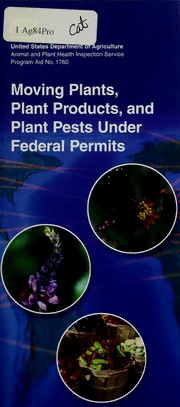
Moving plants, plant products, and plant pests under federal permits PDF
Preview Moving plants, plant products, and plant pests under federal permits
Historic, Archive Document Do assume not content reflects current scientific knowledge, policies, or practices. Ag84Pro I Introduction In today's global marketplace, the volume of international trade brings increased potential for the introduction of foreign pests and dis- eases that could threaten the safety of American agriculture. The results of such introductions can have a devastating effect on the U.S. food supply, damage our natural resources, and cost hundreds of millions of dollars in eradication and control measures that ultimately result in higher priced agricultur- al products for the consumer. — Figure 1 Chrysanthemum white rust is one ofthe many plant diseases and pests that could accompany shipments of plants and cutflowers into the United States. — Figure 2 Insect larvae could be transport- ed inside plants and plant products where they mature and from which they escape into the surrounding environment. The U.S. Department of Agriculture's (USDA) Animal and Plant Health Inspection Service (APHIS) is responsible for regulating the impor- tation of agricultural commodities into the United States. Additionally, APHIS regulates the importation and interstate movement of plant pests. APHIS' Plant Protection and Quarantine (PPQ) unit issues permits to allow the safe movement of these products into and throughout the country. The following are answers to commonly asked questions concerning permits as they apply to the import of plants and related items into the United States and any movement of plant pests. This leaflet will also provide you with contact and Web site information for additional assistance. Q. What is a permit? A. A permit is a written authorization by the Secretary, including through electronic meth- ods, to move means of conveyance and regu- lated articles (e.g., plants, plant products, plant pests, biological control organisms, and nox- ious weeds) or items that may harbor these organisms, in accordance with the conditions prescribed. Q. Who needs a PPQ permit? A. Any person moving a regulated article into the United States or moving plant pests within the United States. Permits are also required for transit of regulated articles through the United States. Q. What is a biological control organism? A. Any natural enemy predator, or parasite used to control other living organisms. Figure 3—Nurseries can be a pathway forthe spread of the deadly plant pathogen Phytophthora ramorum. — Figure 4 Giant hogweed, a Federal nox- ious weed, produces a watery sap that if exposed to human skin can cause painful blistering and scarring. Q. What is a plant pest? A. The term "plant pest" refers to any living stage of any of the following that can directly or indirectly injure, cause damage to, or cause disease in any plant or plant product: • Protozoans • Nonhuman animals • Parasitic plants • Bacteria • Fungi • Viruses or viroids • Infectious agents or other pathogens • Articles similar to or allied with any of the articles previously specified. Q. What is a noxious weed? A. A noxious weed is any plant or plant prod- uct that can directly or indirectly injure or cause damage to crops (including nursery stock or plant products), livestock, poultry, or other interests of agriculture, irrigation, navigation, the natural resources of the United States, the public health, or the environment. Q. Why would the USDA require me to have a PPQ permit? A. USDA-APHIS requires permits under the authority of the Plant Protection Act of 2000. Import permits are required for regulated arti- cles that pose a risk of introducing exotic plant pests and diseases into the United States. Interstate movement of plant pests, including arthropods, mollusks, plant pathogens, vectors, noxious weeds, nematodes, and items that may harbor these organisms, also requires a PPQ permit. — Figure 5 As caterpillars, normative butter- flies can be very destructive to native plants by feeding on leaves that are necessaryfor plant health. Authorization to move live plant pests may be obtained by permit. PPQ carefully weighs the risks against expected benefits in making deci- sions to issue permits to move live plants, plant pests, noxious weeds, and biological control organisms. — Figure 6 Originating from Asia, a bacterial disease known as citrus canker can destroy entire crops by severely blemishing fruit, defoliation, dieback, and premature fruit drop. Import permits are also required for the move- ment of plants whose populations are threat- ened in the wild and are protected by the Convention on International Trade in Endangered Species of Wild Fauna and Flora (CITES). To find out which species fall under the CITES ban, visit http://www.cltes.org on the Web.
